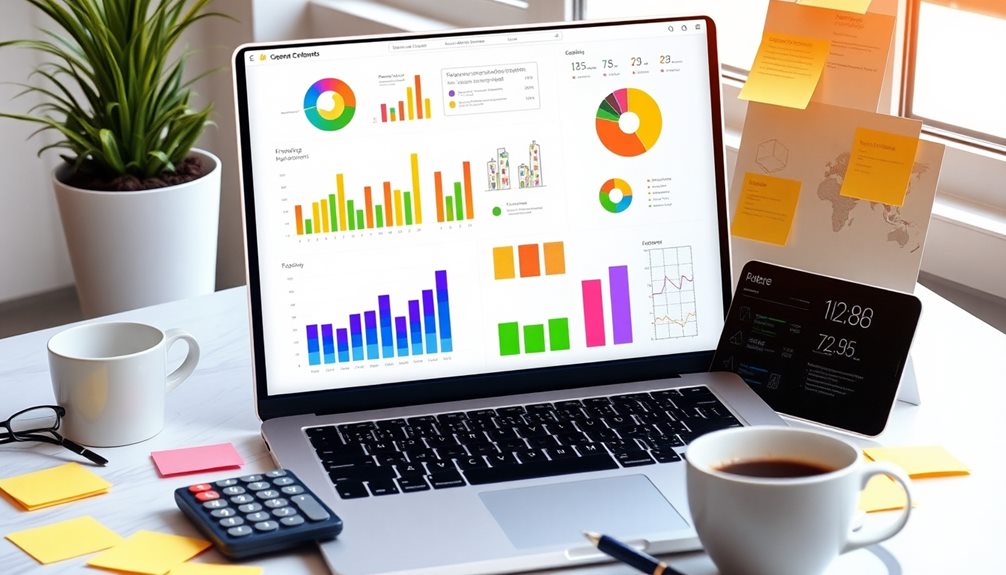If you're considering mental health app development, you're entering a lucrative market projected to grow from $6.1 billion in 2023 to $17.5 billion by 2027. Developers can earn significant income through various monetization strategies like subscriptions, freemium models, and in-app purchases. Basic app development starts around $20,000, while complex apps can cost up to $140,000. The potential for recurring revenue is high, especially with an expanding user base driven by rising mental health concerns. Explore the features and strategies that can boost your app's success and guarantee you capitalize on this growing opportunity.
Key Takeaways
- The mental health app market is projected to grow from $6.1 billion in 2023 to $17.5 billion by 2027, indicating substantial income potential.
- Subscription models generate recurring revenue, providing a steady income stream as users pay for premium features and services.
- The Calm app's success, generating $150 million in revenue in 2019, exemplifies the profitability of mental health applications.
- Free mental health apps dominate the market, but in-app purchases and premium versions can enhance revenue opportunities.
- User engagement techniques, like gamification and community features, can significantly increase app retention rates, boosting overall income potential.
Market Demand and Growth
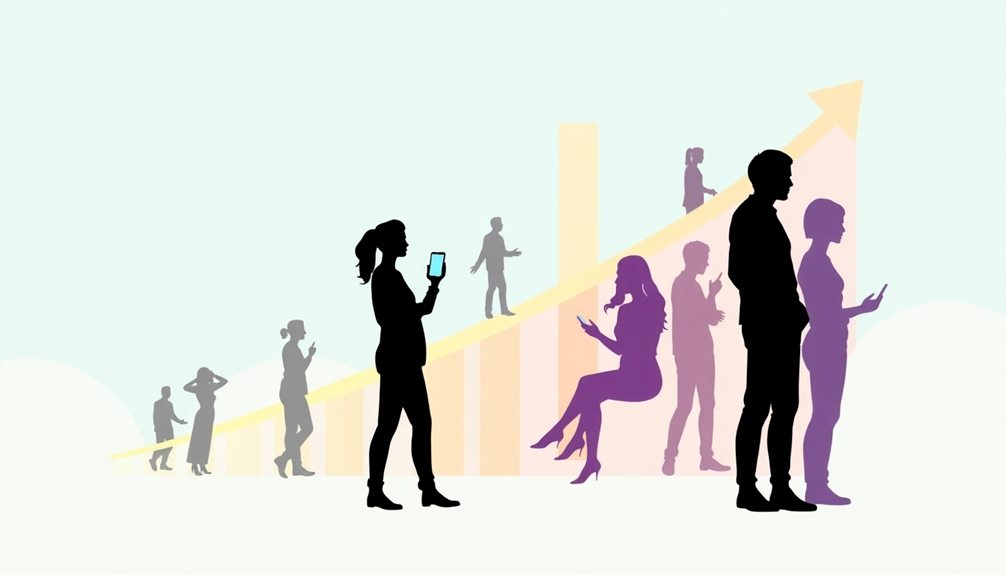
The mental health app market is booming, with projections showing it'll grow from $6.1 billion in 2023 to an impressive $17.5 billion by 2027. This growth reflects a surging market demand for innovative mental health solutions, similar to the rising trends seen in technology like AI privacy advancements that cater to user needs.
With an annual growth rate of 17.9% CAGR expected from 2024 to 2032, the industry is clearly responding to rising mental health disorders and an increasing awareness of well-being.
In 2021, about 57.8 million U.S. adults faced mental health issues, underscoring the urgent need for accessible mental health services through mobile platforms. The depression and anxiety management segment, valued at $1.8 billion in 2023, shows strong consumer interest in targeted mental health apps that effectively address these concerns.
Moreover, free mental health apps represent over 74% of the market share, illustrating a trend towards promoting mental health awareness and reducing stigma.
As you explore mental health app development, you'll realize that tapping into this thriving market isn't just a business opportunity but a chance to make a meaningful impact on individuals seeking better access to mental health care.
Development Costs and Timeline
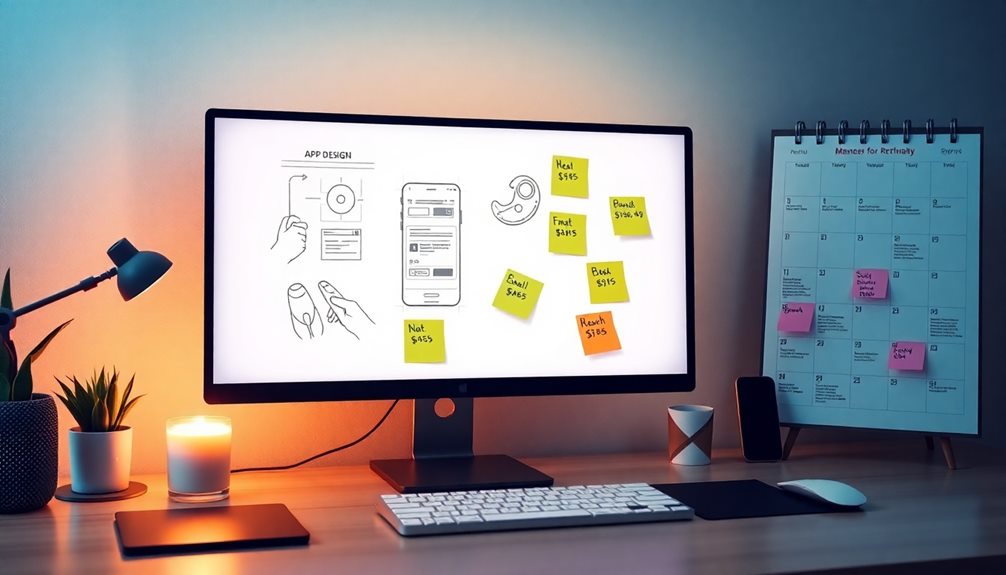
When diving into mental health app development, you'll quickly find that costs can vary considerably based on the app's complexity and features. Understanding the financial requirements is essential for a successful launch.
| App Type | Estimated Cost |
|---|---|
| Basic Mood Tracking | Starts at $20,000 |
| Complex Teletherapy | Starts at $140,000 |
| Ongoing Maintenance | Additional 15-20% of initial costs |
Development timelines also play a significant role. Basic versions of mental health apps typically take 2-5 months to develop, while more complex applications can require 6-12 months. Factors like app complexity, feature set, and the geographical location of your development team can influence both costs and timelines.
As you plan your project, don't forget about ongoing maintenance. After launch, you'll need to budget for support, which can add to your overall financial requirements. By carefully evaluating these elements, you'll be better prepared to create a mental health app that meets users' needs while staying within budget.
Key Features for Success

Successful mental health apps are built around essential features that truly resonate with users. As a mental health app developer, you should prioritize mood tracking, which allows users to log their emotional states, promoting self-awareness and enhancing user engagement during therapy discussions.
Engaging users through the power of online communities can foster a supportive environment, encouraging them to share their experiences and learn from one another.
Incorporating guided meditation and relaxation exercises can greatly boost user retention, as seen with popular apps like Headspace and Calm. Additionally, offering customizable medication reminders helps users stick to their treatment plans, a vital aspect of managing conditions like anxiety and depression effectively.
In-app human support is another key feature; access to licensed therapists enhances the app's credibility and fosters user trust, especially for teletherapy services.
Community features that facilitate peer support can also make a big difference, reducing feelings of isolation during mental health struggles and promoting a sense of belonging among users.
Monetization Strategies
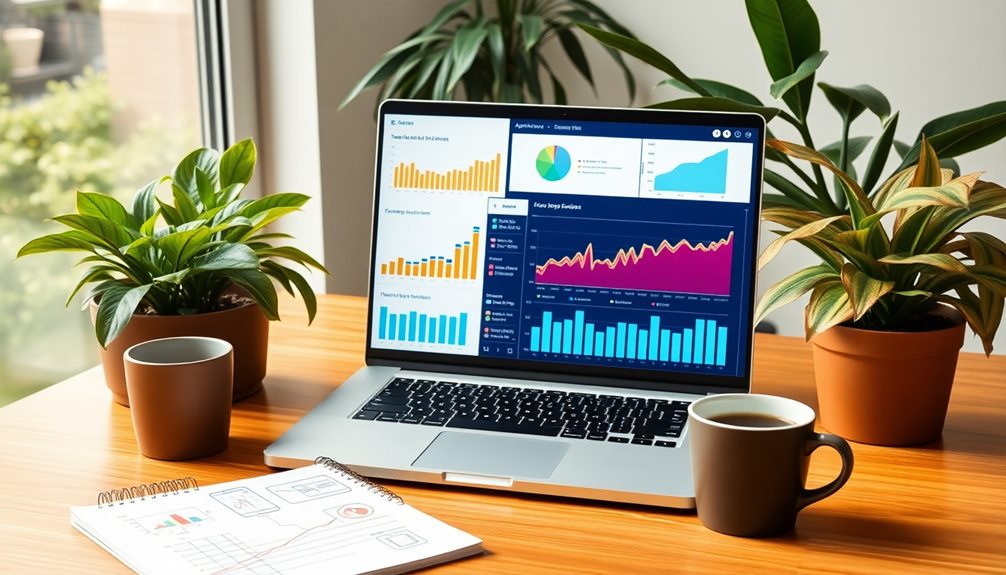
Monetizing your mental health app effectively is as important as incorporating the right features. One of the most popular monetization strategies in the mental health app market is the subscription model. This approach provides ongoing value and predictable income through recurring fees for premium features, ensuring you maintain a steady cash flow.
Additionally, integrating techniques from personal development strategies can enhance user engagement and retention by offering tools that promote mental well-being.
Freemium models are also widely adopted, allowing users to access basic services for free while charging for advanced features. This strategy lets potential users explore your app before committing financially, increasing conversion rates.
In-app purchases, though often underutilized, can create additional revenue streams by allowing users to buy specific services or content directly within the app.
While advertising revenue may seem tempting, it's generally discouraged as it can disrupt user experience. However, non-intrusive advertising could serve as supplementary income if implemented thoughtfully.
Finally, offering paid premium versions of your app, which provide enhanced functionalities and an ad-free experience, can considerably contribute to your app's profitability in a competitive landscape.
Revenue Potential Analysis

Harnessing the growing demand for mental health support, the revenue potential for mental health apps is substantial. The mental health app market is projected to reach $3.7 billion by 2027, growing at an impressive annual rate of 23.7%. This growth opens up numerous opportunities for developers like you.
Subscription-based models are particularly promising, as they often generate recurring revenue by offering premium features that enhance user experience.
With a significant user base driven by the increasing prevalence of mental health conditions, especially anxiety and depression, your app can tap into a burgeoning market. The Calm app, for instance, generated $150 million in revenue in 2019, showcasing the profitability of well-designed mental health applications.
As the global mental health app market was valued at $6.1 billion in 2023, the forecasted CAGR of 17.9% from 2024 to 2032 indicates a lucrative future for mobile app development in this sector.
Compliance and Best Practices
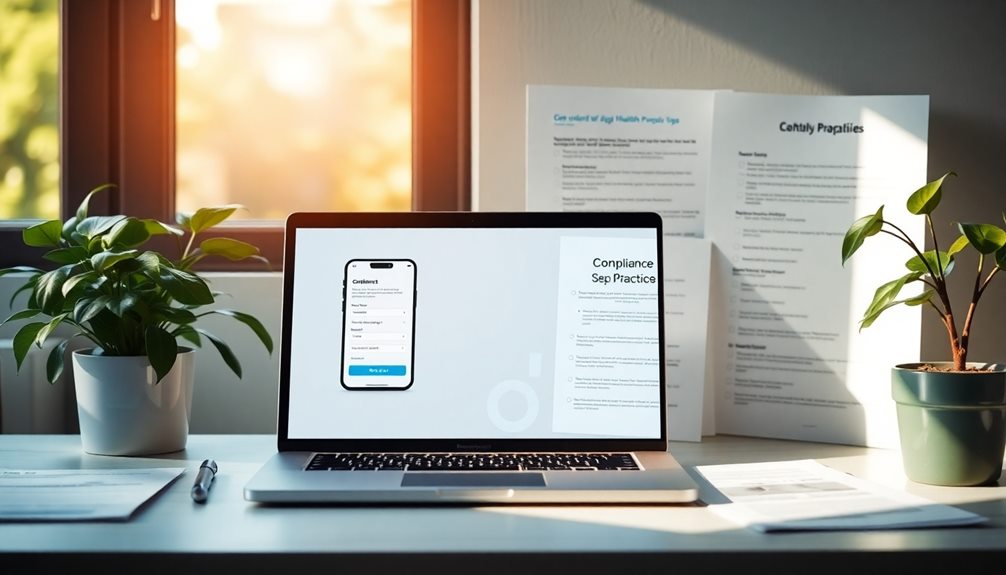
When developing a mental health app, you need to prioritize regulatory compliance to protect user privacy and adhere to standards like GDPR and HIPAA.
Effective design practices, including user feedback integration and expert involvement, enhance your app's credibility and effectiveness.
Regulatory Compliance Standards
Maneuvering the maze of regulatory compliance standards is essential for developing a mental health app that protects user privacy and meets legal requirements. Compliance with the GDPR is critical for apps operating within the EU and EEA, while HIPAA compliance is necessary in the US for handling protected health information.
Here's a quick overview of key compliance factors:
| Compliance Standard | Key Requirement |
|---|---|
| GDPR | Protect personal data rights |
| HIPAA | Guarantee confidentiality and security |
Only 30% of mental health apps involve mental health experts in their development, which is important for meeting these standards and enhancing credibility. Regular audits and updates to your security measures help maintain compliance with data privacy laws and guarantee the safety of sensitive user information.
Before diving into development, it's important to conduct pre-development checks on local laws regarding mental health app regulations. This way, you can avoid potential penalties and guarantee adherence to applicable compliance standards. Keep these factors in mind to create a trustworthy, compliant mental health app that users can feel safe using.
User Privacy Protection
Guaranteeing user privacy protection in mental health app development goes hand in hand with compliance to regulations like GDPR and HIPAA. These laws are essential for safeguarding user data and maintaining confidentiality, especially when dealing with sensitive information.
To effectively protect user privacy, consider implementing the following best practices:
- Robust Security Measures: Use data encryption and conduct regular audits to enhance security. This helps build trust among users, knowing their information is well-protected.
- Transparent User Privacy Policies: Make your user privacy policies clear and easily accessible. Clearly outline how you collect, use, and share user data to comply with legal requirements and boost user confidence.
- Regular Updates and User Feedback Mechanisms: Stay ahead of emerging privacy concerns by regularly updating your app and incorporating user feedback. This guarantees your app remains compliant and responsive to the evolving digital health landscape.
Effective Design Practices
Focusing on effective design practices in mental health app development is essential for creating user-friendly experiences that prioritize both compliance and engagement. Start by implementing user-friendly interfaces that reduce cognitive overload, allowing users to navigate your app seamlessly. This greatly enhances user experience and satisfaction.
Compliance with data privacy regulations like GDPR and HIPAA is critical. Ensuring robust data privacy not only protects sensitive information but also builds trust with users.
Integrate scientifically validated therapeutic resources to enhance your app's credibility and effectiveness. Regularly update content based on user feedback, which fosters continuous improvement and keeps your mental health support tools relevant.
Incorporating personalization features, such as customizable user journeys and mood tracking, can be crucial for meeting individual mental health needs. These elements allow users to engage with the app in a way that feels tailored to them, further improving their experience.
User Engagement Techniques
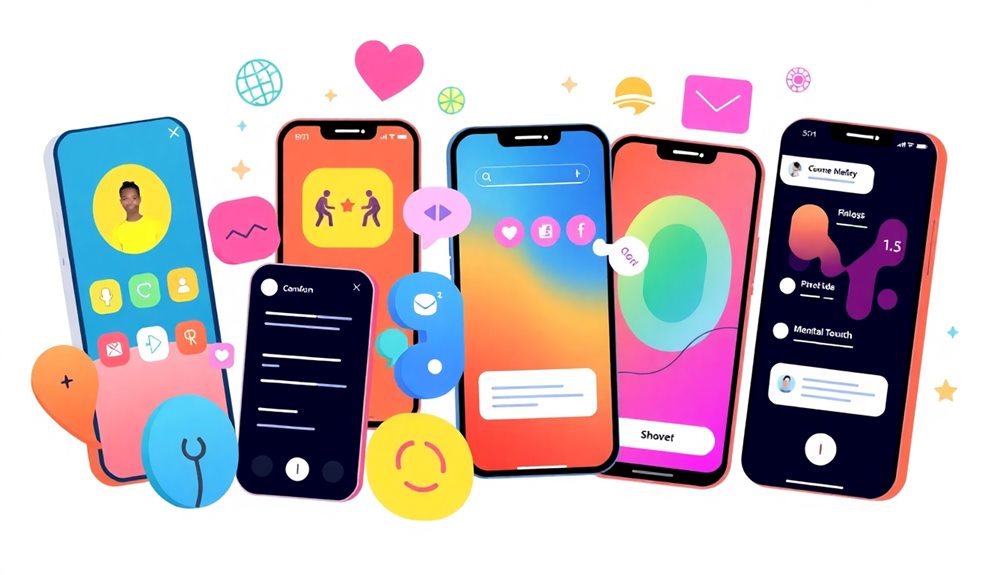
User engagement techniques are essential for the success of mental health apps, as they directly influence user retention and satisfaction. By implementing effective strategies, you can greatly enhance user interaction and boost engagement levels.
Here are three key techniques to take into account:
- Personalized User Experiences: Tailoring content and mood tracking to meet individual needs allows users to feel more connected to the app, improving their overall experience.
- Gamification Elements: Incorporating rewards and challenges can increase retention rates by up to 30%. Users enjoy the competitive aspect, which keeps them coming back for more.
- Community Features: Creating peer support forums helps users feel less isolated. Engaging with others can boost app usage by approximately 40%, fostering a supportive environment.
Additionally, regular push notifications can remind users to interact with the app, potentially increasing daily active user rates by 25%.
Providing educational resources empowers users with knowledge, leading to a 50% increase in the likelihood of returning for ongoing support.
Future Trends in App Development
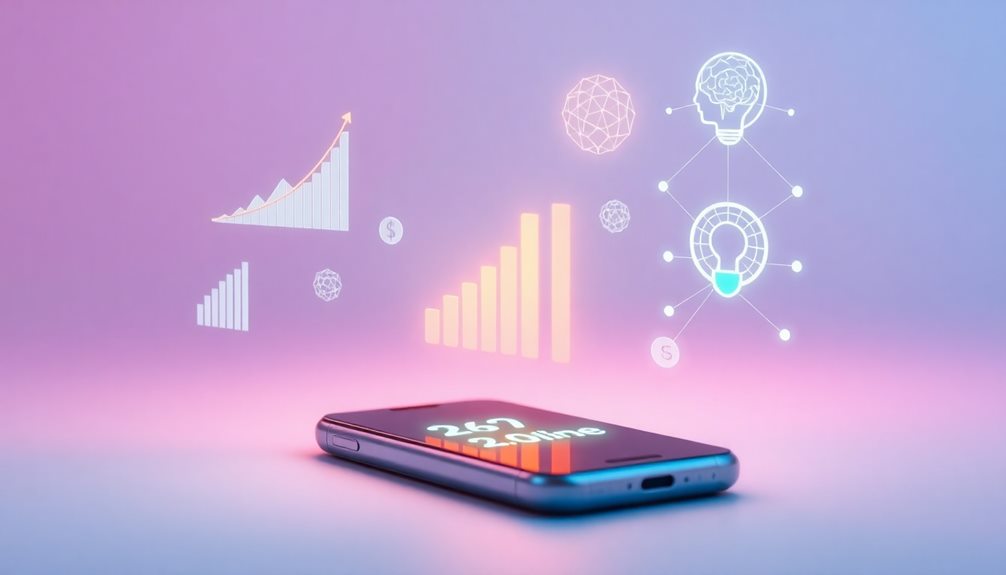
As the mental health app landscape evolves, developers are gearing up for important changes that will shape the future of digital mental health solutions. The market is projected to grow at a compound annual growth rate (CAGR) of 15.2% from 2024 to 2030, indicating a strong demand for innovative mental health app providers.
Subscription-based models are likely to dominate, reflecting users' willingness to pay for premium features and ongoing value.
Artificial intelligence will play a vital role, enabling developers to create apps that offer personalized recommendations tailored to individual needs. This enhancement could greatly improve user engagement and outcomes, making the apps more effective mental health solutions.
Additionally, the rise of corporate wellness programs will increase adoption rates, as organizations seek to bolster employee well-being and productivity.
However, as you navigate this evolving landscape, prioritizing data privacy and security compliance will be essential. Adhering to regulations like GDPR and HIPAA won't only protect users but also build trust in your app development practices.
Frequently Asked Questions
How Much Money Do Mental Health Apps Make?
Mental health apps can make significant money through various revenue streams. Subscription models are particularly profitable, often generating millions annually. As demand grows, you'll find opportunities for substantial income in this expanding market.
How Much Does It Cost to Build a Mental Health App?
Building a mental health app can cost anywhere from $20,000 to over $140,000, depending on its complexity and features. You should also budget for ongoing maintenance and support after launch to guarantee success.
How Do You Monetize a Mental Health App?
To monetize your mental health app, consider subscription models for ongoing value, offer a freemium option to attract users, and include in-app purchases. Paid premium versions and partnerships with healthcare providers can also boost your income.
How Profitable Is the Mental Health Industry?
Imagine a garden flourishing with vibrant blooms; that's the mental health industry. It's thriving, with profits sprouting as demand rises. You'll find opportunities everywhere, from apps to services, nurturing growth and success.
Conclusion
In the fast-paced world of mental health app development, balancing innovation and compliance is essential. While the potential for revenue can be enticing, user trust hinges on your commitment to privacy and care. You can choose to chase trends or focus on genuine user engagement; the latter often leads to sustainable growth. As you navigate this evolving landscape, remember that success isn't just about profits—it's about making a meaningful difference in people's lives.



